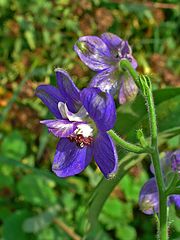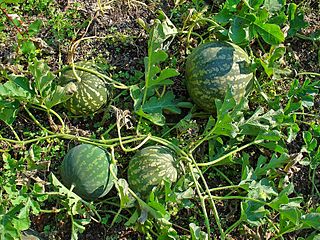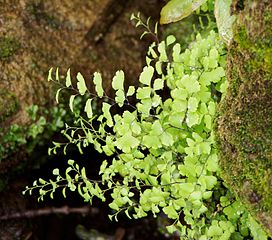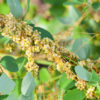
現在医学的に判明している男性の薄毛(AGA)の原因は男性ホルモン型脱毛症は『5αリダクターゼ』による産毛の増加や抜け毛が原因です。その他にも髪の毛を成長させる毛の根元『毛包』の血流の減少も薄毛の原因となっていますし、AGAでは毛包周囲に活性酸素や炎症が増えていますのでこれら①『5αリダクターゼ阻害』と②『血流を改善する』③『抗酸化/消炎』効果がある漢方は薄毛対策になります。昔から薄毛の治療に中国では漢方が使われてきました。
それでは薄毛やハゲに効果がある可能性のある漢方を紹介していきます。
目次
薄毛やハゲに効果があると考えられる漢方
霊芝、ツルドクダミコノテガシワ、オシャグジタケが強い5αリダクターゼを阻害し男性型脱毛症の育毛剤に使える可能性があります[1]。
【霊芝】

wikimedia.org File:Ling_Chih.jpg auther:Jason Hollinger
【ツルドクダミ】

wikimedia.org File:PolygonumMultiflorum.jpg?uselang=ja auther: Fanghong
【コノテガシワ】

wikimedia.org File:PlatycladusOrientalis2.jpg auther:Fanghong
【オシャグジタケ】

wikimedia.org File:Cynomorium_coccineum_2.jpg auther:Hans Hillewaert
葛の花は5αリダクターゼの阻害作用があります[2]。
【葛の花】

wikimedia.org File:Pueraria_lobata_ja02.jpg auther:Miya
ヒルギダマシは5αリダクターゼ阻害作用があるため男性型脱毛症(AGA)の治療に応用できる可能性があります[3]。
【ヒルギダマシ】

wikimedia.org File:Mature_mangrove_tree_(Avicennia_marina)_at_edge_of_Lake_Be_Malae.jpg auther:Colin Trainor
ベニバナは5αリダクターゼ阻害剤で髪の毛の成長促進剤です[4]。
【ベニバナ】

wikimedia.org File:Safflower.jpg auther:Paulatz
ヨウシュチドリソウの種子は血管を新たに増やす作用によって毛の成長を促進します[5]。
【ヨウシュチドリソウ】

wikimedia.org File:Delphinium_staphisagria_003.JPG auther:H. Zell
ネナシカズラ、コロシント、タカサブロウは毛の成長速度を加速します[6][7][9]。
ネシナカズラの育毛作用については別途記事にしていますのでこちらも参照してください。
【ネナシカズラ】

wikimedia.org File:Cuscuta_europaea_bgiu.jpg
【コロシント】

wikimedia.org File:Citrullus_colocynthis_004.JPG auther:H. Zell
【タカサブロウ】

wikimedia.org File:Starr_030807-0168_Eclipta_prostrata.jpg auther:Forest & Kim Starr
キダチコミカンソウは5αレダクターゼ酵素を阻害します[8]。
【キダチコミカンソウ】

wikimedia.org File:Bhoamali_(Phyllanthus_niruri).jpg auther: Ashok modhvadia
ニオイヒバは5αレダクターゼを阻害します[10]。
【ニオイヒバ】

wikimedia.org File:Thuja_occidentalis_foliage_Wisconsin.jpg?uselang=ja auther:Joshua Mayer from Madison, WI, USA
ホウライシダは男性型脱毛症に対して有効です[11]。
【ホウライシダ】

wikimedia.org File:Adiantum_capillus-veneris.jpg?uselang=ja auther:Júlio Reis
ゼラニウムは育毛促進効果があります[12]。
【ゼラニウム】

https://commons.wikimedia.org/wiki/File:Geranium_sibiricum_3.JPG auther:Dalgial
【参考文献】
- Inhibitory activities of some traditional Chinese herbs against testosterone 5α-reductase and effects of Cacumen platycladi on hair re-growth in testosterone-treated mice. Zhang B et al., J Ethnopharmacol. 2016 Jan 11;177:1-9. doi: 10.1016/j.jep.2015.11.012. Epub 2015 Nov 11.
- Inhibitory activities of Puerariae Flos against testosterone 5α-reductase and its hair growth promotion activities. Murata K et al.J Nat Med. 2012 Jan;66(1):158-65. doi: 10.1007/s11418-011-0570-6. Epub 2011 Aug 6.
- Identification of a new plant extract for androgenic alopecia treatment using a non-radioactive human hair dermal papilla cell-based assay. Jain R et al., BMC Complement Altern Med. 2016 Jan 21;16:18. doi: 10.1186/s12906-016-1004-5.
- 5α-reductase inhibition and hair growth promotion of some Thai plants traditionally used for hair treatment. Kumar N et al., J Ethnopharmacol. 2012 Feb 15;139(3):765-71. doi: 10.1016/j.jep.2011.12.010. Epub 2011 Dec 13.
- Promotion of Hair Growth by Traditionally Used Delphinium Staphisagria Seeds through Inducti on of Angiogenesis. Koparal AT et al., Iran J Pharm Res. 2016 Spring;15(2):551-60.
- Development and evaluation of polyherbal formulation for hair growth-promoting activity. Roy RK et al., J Cosmet Dermatol. 2007 Jun;6(2):108-12.
- Effect of Cuscuta reflexa Roxb on androgen-induced alopecia. Pandit S et al., J Cosmet Dermatol. 2008 Sep;7(3):199-204. doi: 10.1111/j.1473-2165.2008.00389.x.
- Evaluation of hair growth promoting activity of Phyllanthus niruri. Patel S et al., Avicenna J Phytomed. 2015 Nov-Dec;5(6):512-9.
- Effect of Citrullus colocynthis Schrad fruits on testosterone-induced alopecia. Dhanotia R et al., Nat Prod Res. 2011 Sep;25(15):1432-43. doi: 10.1080/14786410802632820. Epub 2011 Jul 8.
- The extract of Thujae occidentalis semen inhibited 5alpha-reductase and androchronogenetic alopecia of B6CBAF1/j hybrid mouse. Park WS et al., J Dermatol Sci. 2003 Apr;31(2):91-8.
- Effect of Adiantum Capillus veneris Linn on an Animal Model of Testosterone-Induced Hair Loss. Noubarani M et al., Iran J Pharm Res. 2014 Winter;13(Suppl):113-8.
- Hair growth-promoting effect of Geranium sibiricum extract in human dermal papilla cells and C57BL/6 mice. Boisvert WA et al., BMC Complement Altern Med. 2017 Feb 13;17(1):109. doi: 10.1186/s12906-017-1624-4.

